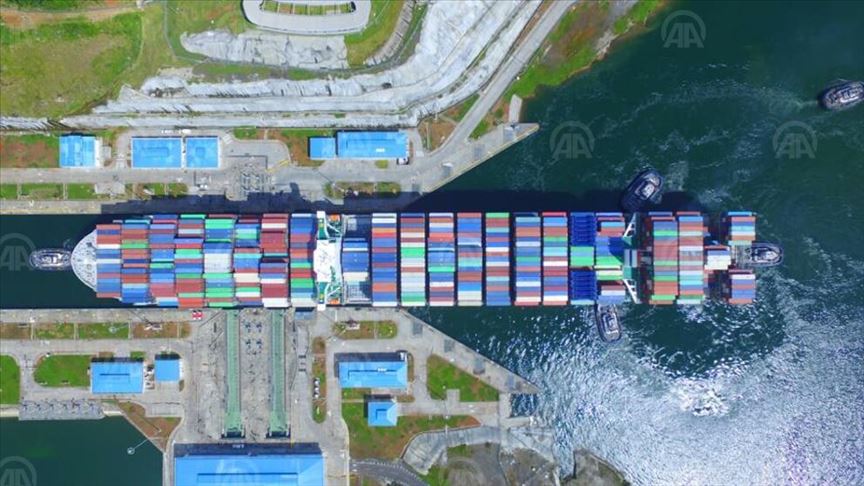Live Makkah
Live Madinah
Urdu Font Download
Latest News:
Padubidri: Fishing boat capsizes; all 7 fishermen on board rescued Alleged atrocity on lawyer: Punjalakatte SI suspended Moral policing at jewellery shop: 4 arrested Bajrang Dal activists try to assault youth, girlfriend in Mangaluru SC to hear Bilkis Bano’s plea against release of 11 convicts on 13 Dec Nusrat Noor: First Muslim Woman to Top Jharkhand Public Service Commission
Latest News:
Padubidri: Fishing boat capsizes; all 7 fishermen on board rescued Alleged atrocity on lawyer: Punjalakatte SI suspended Moral policing at jewellery shop: 4 arrested Bajrang Dal activists try to assault youth, girlfriend in Mangaluru SC to hear Bilkis Bano’s plea against release of 11 convicts on 13 Dec Nusrat Noor: First Muslim Woman to Top Jharkhand Public Service Commission
Panama marks 20 years in charge of the Canal

CUNDINAMARCA, 01 Jan 2020 [Fik/News Sources]: Panama commemorates Tuesday, 20 years of the national administration of the Panama Canal, an historical event that marked the country’s economy, as the interoceanic way contributes 6% of its national GDP.
On Dec. 31, 1999, the U.S. handed over control of the Canal to the Central American country, as established in the Torrijos-Carter Treaty and the Panamanian flag flew alone for the first time on the interoceanic passage.
The current government of Laurentino Cortizo commemorated 20 years of control over the canal with official acts and speeches. Cortizo spoke about the transfer as a fact that "knocked down the fence that divided a country ... which conquered a noble people and united us."
Among those attending the commemoration was former President Mireya Moscoso, who served during the delivery of the interoceanic route. He recalled it was a date full of stir and patriotism. "It was a very big emotion," he told local television network TVN.
President of the Panama Canal Practitioners Association Alvaro Moreno explained to local media that the transfer meant the country had reached its sovereignty.
The history of the canal
The U.S. took on the challenge of building the immense engineering work in 1903, after the French failed in an attempt.
French chief engineer, Philippe-Jean Bunau-Varilla, had no funds to continue the work and gave up the rights of exploitation and construction of the canal to the US, as well as control of the area surrounding the canal.
The U.S. paid $10 million for the way and agreed to give an annual income $250,000 to Panama. The transaction was signed in the Hay-Bunau-Varilla Treaty on Nov. 18, 1903, 15 days after Panama declared its independence from Colombia.
The Americans took about 10 years to build the interoceanic highway. During that time, builders had to dig through the Continental Mountain Range, the largest dam in the world at that time, as well as design an unprecedented sluice system.
As time went by, Panamanians began to express dissatisfaction with the use of the channel by the Americans and it led into violent protests.
In 1970, Panama began negotiations with the U.S. to gain control over the passage.
In 1977, President Omar Torrijos, who assumed his post after a military coup, and then-U.S. President Jimmy Carter, signed a treaty stipulating the Central American country would gradually recover sovereignty of the canal.
In 1999, after a rough bilateral relationship which included the 1989 invasion of the U.S. into Panama that concluded with the capture of strongman Gen. Manuel Antonio Noriega and thousands dead, Carter delivered the channel to Moscoso, who said: "Thank you, it's finally ours!"
The Canal today
In June 2016, Panama began the expansion of the canal. It used steel that would be necessary to raise 22 Eiffel Towers, as well as 4.5 million cubic meters of concrete, the amount used to build 2.2 Egyptian pyramids or 450 20-story buildings.
In January 2017, the Canal recorded a new monthly tonnage record. It reached 36.1 million tons of ware in 1,260 vessels. In February of that year the daily average reached 1.18 million tons.
The distance vessels have to travel between the Atlantic and Pacific oceans is 77 kilometers (48 miles), and spend between eight and 10 hours.
Today the main routes that use this interoceanic passage are those that travel between Asia and the eastern U.S. (51.2%), between the west coast and the east coast of the U.S. (17.5%), and between the west coast of South America and Europe (10.6%).
The vessels that transit through the expanded channel are container ships, liquefied petroleum gas (LPG), liquefied natural gas (LNG), bulk carriers, vehicle carriers, tankers and passenger ships.
One of the main problems facing the future route is the lack of water. The canal depends on water that accumulates in the Gatun and Alajuela artificial lakes, on which more than 2 million people live in Panama City also depends.
Global warming, the expansion of the canal and its continued use for 103 years have put strong pressure on water sources.
In this commemoration, the canal faces the lowest levels of rainfall in its river basin, which impacts the water supply consumed by half of the country and allows the canal to function.
The Panama Canal Authority is currently conducting feasibility studies on water reservoirs to preserve this engineering megastructure.
Prayer Timings
| Fajr | فجر | |
| Dhuhr | الظهر | |
| Asr | أسر | |
| Maghrib | مغرب | |
| Isha | عشا |







